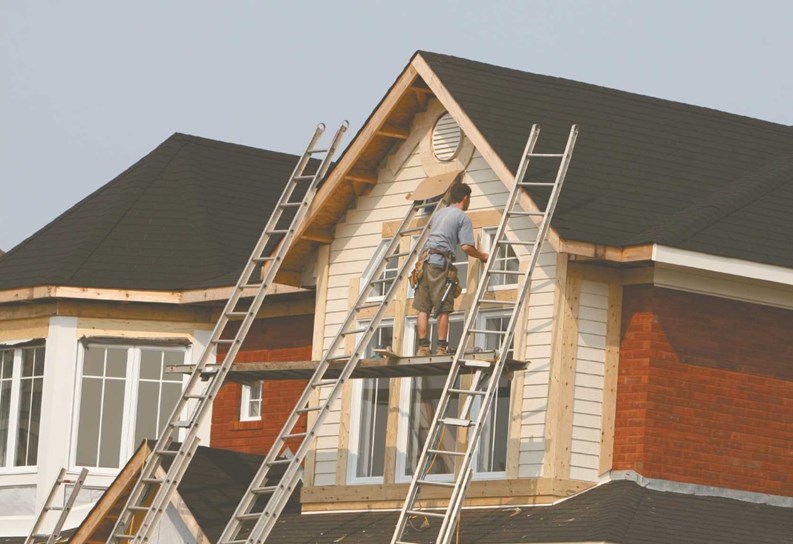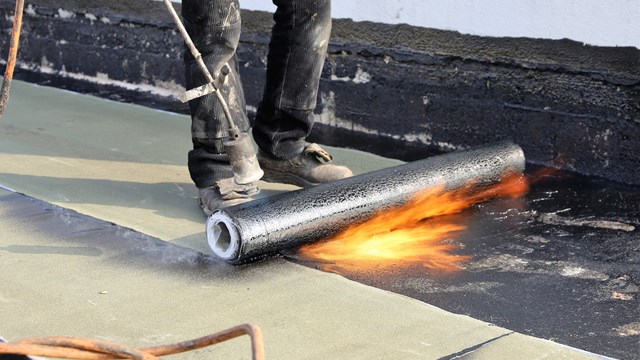The workers are there in plain sight, going about their jobs with intensity, laboring on the buildings around us—maybe even in your own HOA. But what are they doing, exactly? What does it mean when a contractor is hired to do a façade restoration job, or to work on an association's windows? Unless you have some training in engineering or construction methods, it's probably tough to say.
In the course of an exterior job, workers could be accomplishing several things, including repairing or replacing a façade, maintaining a building's windows, or any number of other tasks. Even with that variety, there are some fairly common kinds of exterior/façade jobs done in New Jersey's urban and suburban condo communities and you don't have to be a contractor or an engineer to have an idea of what such projects entail.
While scaffolds, suspended riggings and industrial-strength contractors' ladders are a common enough sight around community associations, having some notion of what those workers are doing up there can be helpful whenever your own association or building undergoes a similar repair or renovation project in the future. Understanding some of those details could save you time and money in the future.
Knowing What to Look For
When a contractor or inspector examines the exterior of a residential building, he is looking for signs of problems or potential problems. While there is no official façade/exterior checklist that every contractor uses when inspecting a building's exterior, experienced contractors generally scrutinize buildings by looking for certain things, says Andrew Amorosi, co-owner of The Falcon Group's Falcon Engineering in Bridgewater.
"The main issue with the façade is water infiltrating, or deterioration of the actual façade material. Deterioration could require replacement of that material," Amorosi says. "We look for a leak history around windows or balconies—that's a red flag that façade restoration should be done."
Because of the wide variation in residential building façades, it's not practical to have an official façade/exterior checklist, Amorosi says, explaining that there are often clear signs and symptoms of exterior maintenance problems. "Cracks and missing joints in the bricks are signs of a problem, as is rusting, revealing reinforcement bars in the concrete," he says. "Scaling of concrete and mortar crumbling out of bricks also is a sign of a problem."
Poor maintenance of a building often will leave a trail, adds Robert Gendusi, owner of Eagle General Contractors in Trenton.
"Telltale signs of poor maintenance include things like lot of caulking around windows and doors, tar on the roofs—stuff done by a maintenance man, rather than a real correction of the [maintenance] problem," Gendusi says. "I look for signs of people doing work on the building that is inconsistent with good construction practices."
Like Amorosi, Mitchell Frumkin looks for signs of water leaking into the building when he scans a building for problems. The most common types of leaks occur around a homeowner's windows or are roof leaks, says Frumkin, president of Kipcon Inc., an engineering consulting company that does a lot of work with associations.
Associations sometimes call for a reserve study to be done on their building, Frumkin continues. "A reserve study tells how much useful life is left in your roof, for example. A reserve study prepares you by allowing you to budget for replacement of the roof."
A New Coat May Not Cut It
The most common kind of façade or exterior work done on residential buildings in New Jersey is usually waterproofing. On masonry structures, a contractor often will restore the façade by doing repairs where needed and then applying a protective coating to the building's exterior. The protective coating will temporarily seal the stone or brick of the building to prevent water from seeping in. The process will need to repeated in a few or several years, depending upon the product.
Another common type of exterior improvement done to residential buildings is applying a new coat of paint or sealant to a building's trim, siding or masonry. Painting the siding or sealing the brickwork is a regular maintenance job that is done every several years, depending upon the product. Trim or siding can be hand-painted, or the paint can be sprayed on with industrial paint sprayers. Brick and stone sealant is usually sprayed on when applied. In addition to preserving the siding or trim beneath it, paint also temporarily waterproofs whatever it covers.
Pointing is a waterproofing process often used to repair a building's exterior and make it watertight. In re-pointing a building's exterior, workers scrape out loose old mortar from the joints between the bricks or stones and replace the mortar with new mortar to prolong the life of the bricks or stone and the rest of the building.
All of the aforementioned jobs take varying amounts of time to complete, depending upon the speediness of the contractor and the size of the building. With smaller buildings, these jobs can be often be done by workers laboring on ladders. For larger buildings, a contractor might need to use scaffolding to do a painting or waterproofing job, as well as with other major exterior work, such as siding repair.
Both Structural & Cosmetic
A fairly routine—though costly—type of structural repair is repair or replacement of balconies. Because of the limits of concrete and steel reinforcing rods in concrete, balconies made of concrete must sometimes be repaired or replaced. Repairing worn-out or structurally deficient balconies is probably the most prevalent type of structural repair, Amorosi says.
Other repairs are purely elective, and are done to improve the overall appearance of the building, Amorosi continues.
"What we're seeing right now is that a lot of older buildings are updating their look," he says. "They are improving the façade and using new materials to compete with the new structures—maybe change the roof line a little, or something else. The before-and-after can be dramatic, and it adds value to the building."
Repairing or replacing vinyl siding, stucco and wooden shake shingles also are common maintenance jobs done to residential buildings. The most common type of repair to wood siding is applying a coat of paint to it, Frumkin says.
"You have to paint wood siding every year," Frumkin says. "More associations are getting rid of wood siding for a maintenance-free siding."
Because windows can become outdated and inefficient fairly quickly, window replacement also is a common repair done to residential buildings. Often, wood window trim, which can be affected by the elements, is replaced with plastic, which is more durable.
Small Leak, Big Problem
Some engineers and contractors say the toughest exterior jobs involve water leaks into a building. Because water leaks often appear small and not particularly threatening, quick fixes often are used to "repair" the affected area of the building. Such fixes rarely work in the long run, experts say.
"You could have a roof leak and put tar on it, which is a cheap fix. But the problem will come back because it's not an adequate fix," Frumkin says.
Indeed, the most technically demanding or difficult kind of exterior work, from the point of view of the contractor and his/her crew, can be finding and fixing a water leak, says Frumkin.
"Until you start taking apart the siding or the shingles to see where the water's coming from, you don't know what you've got," Frumkin says. "You trace the water leak back to its source."
Obviously, tearing apart a roof or ripping off a large portion of siding or shingles from a building will create another problem: repairing the material torn apart in the project. Such project vagaries can lead to escalating costs on an exterior renovation project.
Resolving an issue with a water leak in a building is often the hardest exterior project for a contractor to deal with, Gendusi agrees. "When resolving leak issues, a building constructed with a stone façade is particularly difficult to deal with. It's much more difficult than a vinyl-sided property," he says.
Because a contractor may have to peel off large amounts of stone or brick to find the source of a water leak, quite a bit of damage could be done to the façade while searching for the source of the leak. Some of the stone or brick could be damaged and unusable, requiring replacement, which might present another problem, Gendusi says. "Not all brick facades can be patched with the exact same color brick," he says.
Many Variables
Because of the size and complexity of some of the exterior jobs that are done on residential buildings, it often is difficult to judge exactly how long a particular project might take. The lack of adequate materials, too few workers, or other factors can drag out a job that would seem to be an easy one to complete.
"These projects are enormous in scope, with scaffolding, etc. And the weather is always a factor," Amorosi says. "They're very complex jobs, requiring a lot of safety and logistics considerations. Many of these jobs have six workers or more working on them."
When considering a large exterior project for a building, management teams should consider the impact the project will have on the residents, as well as the overall affect of the improvement that will be done.
"Every building needs to be scrutinized for what it is," Amorosi advises. "A full building evaluation is really the first step."
Jonathan Barnes is a Pittsburgh freelance writer and a frequent contributor to The New Jersey Cooperator.







Leave a Comment